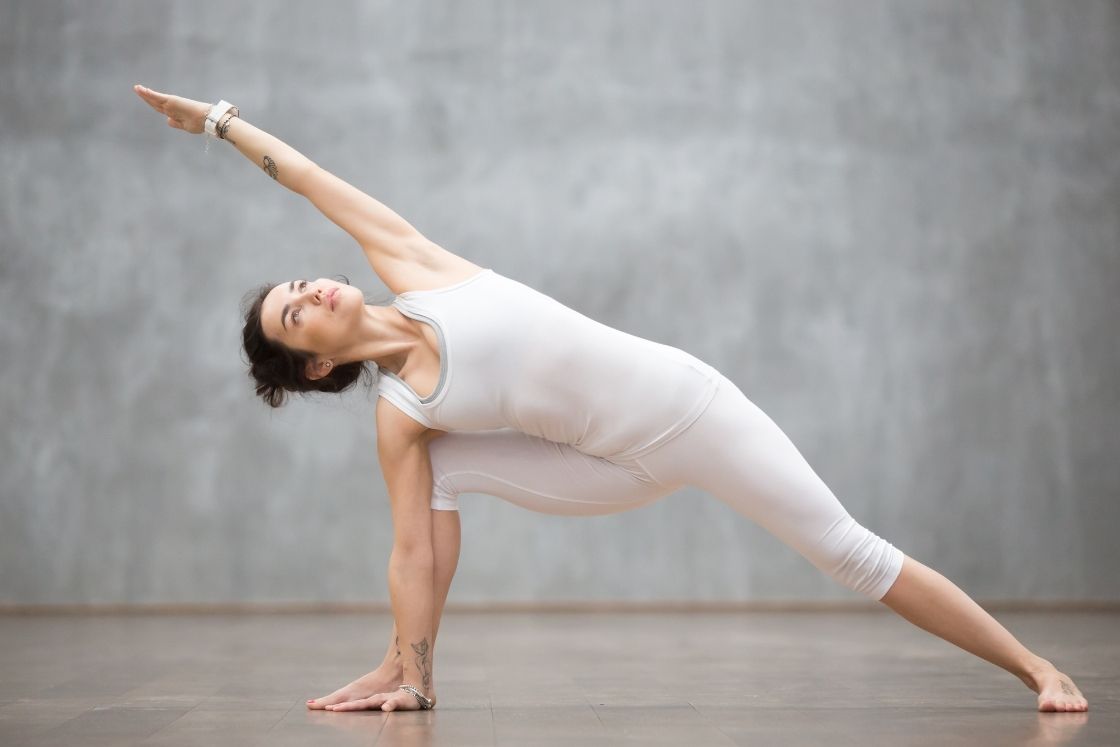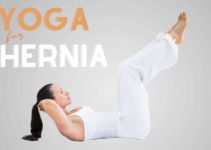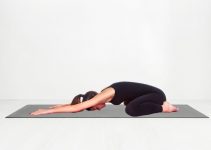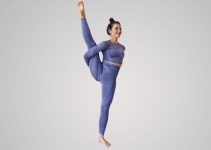
Parivrtta Parsvakonasana, also known as Revolved Side Angle Pose is a standing twist posture. Based on the difficulty level, it’s considered an intermediate level of yoga asana.
It involves twisting of the torso and requires a sense of balance, therefore it is also considered as a balancing pose too. The asana focuses on stretching and strengthening the legs, knees, and ankle. It also provides deep stretches into the groin, spine, and shoulders.
Besides strengthening the body physically, it enhances the cleansing mechanism of the body. Being a twisting pose, revolved side angle pose improves blood circulation thereby facilitating the detoxification process.
Parivrtta Parsvakonasana forms one of the sequences of the Ashtanga Yoga Series.
Parivrtta Parsvakonasana Meaning
To deep dive into the meaning of parivrtta parsvakonasana it is better to break it down into its root terms. It is composed of four Sanskrit terms, Parivrtta+ Parsva+ Kona+ Asana.
- ‘Parivrtta’ which means ‘to turn’ around or ‘revolved’
- ‘Parva’ refers to ‘side’ or ‘flank’
- ‘Kona’ means ‘angle’
- ‘Asana’ is ‘pose’.
Torso in this pose is revolved sideways while making an angle from the back stretched leg. Based on this action, it’s also called “Twisting Side Angle,” “Rotated Side Angle,” or “Side Angle Twist.
Along with twisting of the torso, it squeezes the abdominal organs. The sideways twist requires great flexibility and strength.
Contraindications
- Avoid parivrtta parsvakonasana if you have high or low blood pressure. The twist involved in the pose decreases breathing capacity that ultimately affects the blood pressure.
- Do not practice the asana if you are a patient of migraines.
- Never perform this pose with an injury into the hip or neck region.
- Avoid it during pregnancy as the lower abdomen is involved in the twisting that blocks proper and smooth breathing.
- Don’t practice it if you are an insomniac.
Preparatory Poses
- Classic Sun Salutation (Surya namaskar)
- Chair Pose (Utkatasana)
- Revolved Standing Forward Fold Pose (Parivratta Uttanasana)
- Bound Angle Pose (Baddha Konasana)
- Cow face pose (Gomukhasana)
- Downward-facing dog pose (Adho Mukha Shvanasana)
- Wide angle seated forward bend pose (Upavistha Konasana )
- Revolved Triangle Pose (Parivrtta Trikonasana)
Instructions
- Begin with the mountain pose and then spread your legs apart for 3-4 feet.
- Turn the right foot outwards to 90° keeping the spine straight.
- Join your hands together forming a prayer pose.
- Bend your right knee keeping the thigh parallel to the ground.
- Gently start twisting your upper body towards your right dropping your left elbow over the right knee simultaneously.
- Twist a little by looking up to the ceiling.
- Hold the position for 2-3 breaths/
- Inhale and come back to the center.
- Bring your hands down, exhale, and bring your feet closer.
- Repeat the same steps with the left foot.
Then release and relax in the mountain pose.
Beginners often struggle in maintaining the balance in revolved side angle pose. Take support against a wall initially to maintain stillness in the back foot.
Precautions
- Perform the asana without shifting the gaze up to the ceiling to prevent jerk on the neck.
- Distribute the body weight evenly rather than concentrating it on the arms and legs.
- Maintain the posture with proper alignment of the body to prevent any injury.
- Proper supervision is required for such an intense pose to apply the correct amount of energy and pressure.
Modifications and Props
- Parivrtta parsvakonasana aerial – Using a fabric tied as a hammock to perform this asana could be used to modify the pose. It will keep the bent knee steady and balancing becomes easy.
- Against a wall – Perform the asana taking support from a wall. While maintaining the stretch keep the back foot touched to the wall.
Follow-up poses
- Eagle pose (Garudhasana)
- Half Lord of the Fishes Pose (Ardha Matsyendrasana)
- Marichi Sage Twist Pose (Marichiyasana)
- Torso Stretch Pose (Bharadvajasana).
Parivrtta Parsvakonasana Benefits
1. Improves digestion
The twist involved in the asana works out best for the abdominal organs, cures constipation, and aids in normal bowel movement.
2. Rejuvenates and Energizes
Parivrtta parsvakonsana involves deep twisting of the organs thereby blocking the blood flow. As the posture is released it maintains the blood flow and helps in detoxifying the toxins present in the body. A study [efn_note] management of diabetes mellitus through asana and pranayama https://www.researchgate.net/publication/328305138_MANAGEMENT_OF_DIABETES_MELLITUS_THROUGH_AASANA_AND_PRANAYAMA [/efn_note] prove that this pose is beneficial in the removal of toxins in the body.
3. Reduces body fat
It involves the torso, hamstring, and whole lower body. Practicing this asana helps in losing weight especially around the hips and waist region.
4. Increases flexibility and balance
Continued practice of parivrtta parsvakonasan makes the body flexible. It strengthens the spine and makes it supple. According to a study [efn_note] Effects of hatha yoga exercises on spine flexibility in young adults https://content.sciendo.com/view/journals/bhk/8/1/article-p113.xml [/efn_note] taking young adults as a subject holding the posture provides extra balance and grip on the body.
5. Increases strength
Revolved side angle pose strengthens the thighs and knees. Holding the final position makes the thighs and knees firm ultimately providing them strength and endurance.
6. Tones the lower body
The pose is focused on to lower body and tones the ankles, calves, groin, and quads.
7. Therapeutic action
Revolved side angle pose relieves the lower back pain. It is recommended as a remedial posture to cure sciatica.
8. Increases lung capacity
Parivrtta parsvakonsana expands the lungs’ capacity thereby improving and rejuvenating the respiratory system. It benefits by increasing the oxygen rates into the brain [efn_note] Perceived benefits of yoga among students http://innpharmacotherapy.com/VolumeArticles/FullTextPDF/10201_IPP_08-AJ-2020-11.pdf [/efn_note]
Variations
- Easy revolved side angle pose – Parivrtta parsvakonasana can be performed by keeping the back knee bent and touched to the ground. It makes it easier to hold the pose.
- Easy Revolved Side Angle Pose Variation Gentle Twist – It does not require hands to be joined in prayer pose. While performing the pose on the right leg keep the right hand on the hips and left hand on the knee and twist gently. Keep the left foot to the floor.
- Joining the hands behind – With the right knee bend drop the right elbow to it and take left arm behind. Try to grab the right arm from the left hand under the right thigh.
Conclusion
Parivrtta parsvakonasana is an intense twisting posture. It takes time and practice to reach the posture with integrity. However, the health benefits of the posture prove its worth.





Does Parivratta Parsvakonasana activate Samana Vayu ? Pl guide
Yes, as the abdominal muscles get a good stretching in Parivratta Parsvakonasana it activates the Manipura chakra and helps build the Samana vayu in the body.
Can Glaucoma patient practise Parivratta Parsvakonasana? Pl guide
Yes, there is no harm to Glaucoma patients in doing this pose. It’s simply a side torso stretching pose, however, if one has Glaucoma or eye-related problem, don’t use Drishti (strongly gazing at one point) in asana practice.